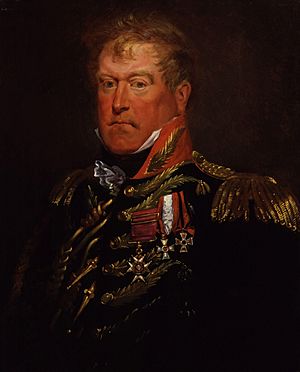George Adam Wood facts for kids
Quick facts for kids
Sir
George Adam Wood
|
|
|---|---|
 |
|
| Born | 1767 |
| Died | 22 April, 1831 (aged 63–64) London, England |
| Allegiance | |
| Service/ |
|
| Rank | Major General |
| Battles/wars | Peninsular War Battle of Waterloo |
Sir George Adam Wood (1767–1831) was an important officer in the British Army. He is remembered for his service in the Peninsular War and for fighting bravely at the famous Battle of Waterloo in 1815. He received many honors for his courage and leadership.
Contents
Early Life and Military Start
George Adam Wood was born in 1767. His father, Adam Wood, was also a soldier. Young George followed in his father's footsteps.
He studied at the Royal Military Academy, Woolwich in London. This was a special school for future army officers. After his training, he became a second lieutenant in the Royal Artillery in 1781.
Climbing the Ranks
George Wood worked hard and moved up through the army ranks.
- In 1790, he became a lieutenant.
- By 1800, he was a captain.
- He became a major in 1806.
- In 1808, he was promoted to lieutenant-colonel.
- He reached the rank of colonel in 1814.
- Finally, in 1825, he became a major-general.
Campaigns and Battles
Sir George Adam Wood served in many different parts of the world. He was involved in several important military campaigns.
Early Campaigns
From 1793 to 1795, Wood served with the army in Flanders. This area is now part of Belgium and France. He took part in many key battles there.
Soon after, he traveled to the West Indies. There, he helped capture Saint Lucia in 1796. He also helped take Saint Vincent that same year. In 1797, he was part of an expedition that captured Trinidad.
Service in Europe
From 1806 to 1808, Wood served in the Mediterranean Sea. Then, he went to Portugal to fight in the Peninsular War. He was at the Battle of Corunna in 1809. After this battle, he returned to England with the British army.
Later in 1809, he joined an expedition to Walcheren. This was an island off the coast of the Netherlands. He helped in the siege and capture of Flushing.
In 1812, he was honored for his service and became a knight. This meant he could use the title "Sir."
Fighting in Holland and Flanders
In 1813, Sir George Adam Wood commanded the Royal Artillery in Holland and Flanders. His troops worked with other allied armies. He landed in Rotterdam and was part of the Siege of Antwerp in 1814. He also fought in the action at Merxem.
He was involved in the attack on Bergen op Zoom. Although the attack was not successful, he continued to blockade the area. For his bravery, he was promoted and became an aide-de-camp to King George IV. This meant he was a special assistant to the King.
The Waterloo Campaign
In 1815, Sir George Adam Wood played a very important role in the Waterloo Campaign. He was in charge of all the Royal Artillery. This included all the cannons and big guns used by the British army.
He led his artillery forces in two major battles:
- The Battle of Quatre Bras on June 16.
- The famous Battle of Waterloo on June 18.
After these victories, he marched with the army to Paris. He helped in operations against several French fortresses. Finally, he entered Paris with the allied forces on July 7.
Honors and Awards
For his amazing service in the Waterloo Campaign, Sir George Adam Wood received many awards:
- He was mentioned in official reports for his bravery.
- He was made a Companion of the Order of the Bath (CB).
- He received the Waterloo Medal.
- He was allowed to wear honors from other countries, including Russia, the Netherlands, and Austria.
- In 1816, he was made a knight commander of the Royal Hanoverian Guelphic Order (KCH).
After the war, he commanded the British artillery in France until 1819.
Later Life
In 1825, Sir George Adam Wood was appointed Governor of Carlisle. This was an important position in England.
He passed away in London on April 22, 1831.

